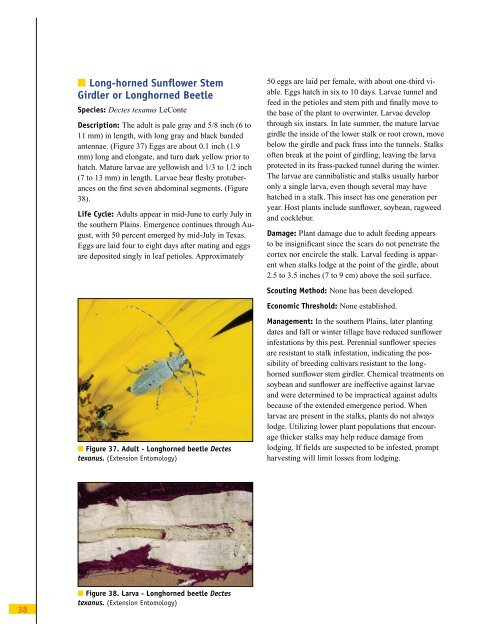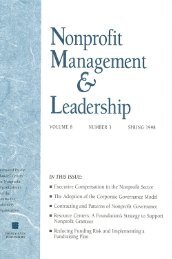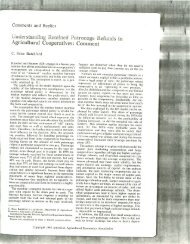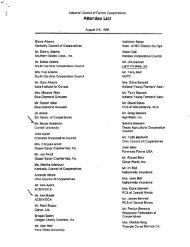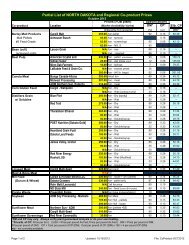Sunflower Production Field Guide - Your "Home Page"
Sunflower Production Field Guide - Your "Home Page"
Sunflower Production Field Guide - Your "Home Page"
Create successful ePaper yourself
Turn your PDF publications into a flip-book with our unique Google optimized e-Paper software.
38<br />
■ Long-horned Sunfl ower Stem<br />
Girdler or Longhorned Beetle<br />
Species: Dectes texanus LeConte<br />
Description: The adult is pale gray and 5/8 inch (6 to<br />
11 mm) in length, with long gray and black banded<br />
antennae. (Figure 37) Eggs are about 0.1 inch (1.9<br />
mm) long and elongate, and turn dark yellow prior to<br />
hatch. Mature larvae are yellowish and 1/3 to 1/2 inch<br />
(7 to 13 mm) in length. Larvae bear fl eshy protuberances<br />
on the fi rst seven abdominal segments. (Figure<br />
38).<br />
Life Cycle: Adults appear in mid-June to early July in<br />
the southern Plains. Emergence continues through August,<br />
with 50 percent emerged by mid-July in Texas.<br />
Eggs are laid four to eight days after mating and eggs<br />
are deposited singly in leaf petioles. Approximately<br />
■ Figure 37. Adult - Longhorned beetle Dectes<br />
texanus. (Extension Entomology)<br />
■ Figure 38. Larva - Longhorned beetle Dectes<br />
texanus. (Extension Entomology)<br />
50 eggs are laid per female, with about one-third viable.<br />
Eggs hatch in six to 10 days. Larvae tunnel and<br />
feed in the petioles and stem pith and fi nally move to<br />
the base of the plant to overwinter. Larvae develop<br />
through six instars. In late summer, the mature larvae<br />
girdle the inside of the lower stalk or root crown, move<br />
below the girdle and pack frass into the tunnels. Stalks<br />
often break at the point of girdling, leaving the larva<br />
protected in its frass-packed tunnel during the winter.<br />
The larvae are cannibalistic and stalks usually harbor<br />
only a single larva, even though several may have<br />
hatched in a stalk. This insect has one generation per<br />
year. Host plants include sunfl ower, soybean, ragweed<br />
and cocklebur.<br />
Damage: Plant damage due to adult feeding appears<br />
to be insignifi cant since the scars do not penetrate the<br />
cortex nor encircle the stalk. Larval feeding is apparent<br />
when stalks lodge at the point of the girdle, about<br />
2.5 to 3.5 inches (7 to 9 cm) above the soil surface.<br />
Scouting Method: None has been developed.<br />
Economic Threshold: None established.<br />
Management: In the southern Plains, later planting<br />
dates and fall or winter tillage have reduced sunfl ower<br />
infestations by this pest. Perennial sunfl ower species<br />
are resistant to stalk infestation, indicating the possibility<br />
of breeding cultivars resistant to the longhorned<br />
sunfl ower stem girdler. Chemical treatments on<br />
soybean and sunfl ower are ineffective against larvae<br />
and were determined to be impractical against adults<br />
because of the extended emergence period. When<br />
larvae are present in the stalks, plants do not always<br />
lodge. Utilizing lower plant populations that encourage<br />
thicker stalks may help reduce damage from<br />
lodging. If fi elds are suspected to be infested, prompt<br />
harvesting will limit losses from lodging.


